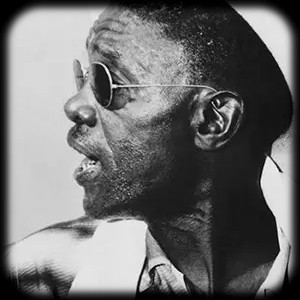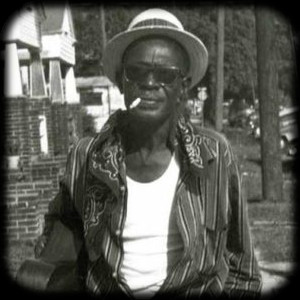LIGHTNIN’ HOPKINS

Sam 'Lightnin' Hopkins was a master stylist of Blues guitar, who had an engaging talent for improvising humorous lyrics to his vast repertoire of songs.
His complex guitar work had the flavour of early Texas Blues styles, and although his voice was dry and scratchy, his songs and the spontaneous stories he told at his gigs were rich, poetical and profound.
His eccentric attitude to tempo made him more a solo artist than frontman for a band, but his dexterity and command of riffs and runs meant there was always plenty to listen to.
When Sam Hopkins was 8 years old, he performed with Blind Lemon Jefferson at a country picnic.
Sam went on to help Lemon by being his 'lead-boy' whenever he was in the Houston area, and from then on he was always going to be a Blues player.
Sam's older cousin Texas Alexander was a popular Blues singer, and Sam played with him all over East Texas for many years.
He worked as a farm labourer, but on Friday and Saturday nights there was always a party to play. “I didn't have to do too much cotton-pickin'!”
Hopkins did some jail-time in the 30's and he vividly describes working on a road-gang and being shackled to his bunk at night.
He died with shackle scars on his ankles, as well as a big scar from when he was stabbed on the eve of being drafted into WWII.
When he got out of jail again, he teamed up with Texas Alexander for some gigs, but when they were offered a record deal with West Coast label Aladdin in 1946, his cousin didn't take it up.
Lightnin's song, 'Bring Me My Shotgun';
The recording sessions took place in LA with Wilson 'Thunder' Smith, a Houston pianist. The pair were billed as 'Thunder an' Lightning', hence the name Sam used for the rest of his career.
'Katie May' was a regional hit and Lightnin' recorded over 40 tracks for Aladdin, mostly evocative Texas blues from earlier times. At the same time, the wily Lightnin' was recording for several other labels, demanding cash up front before he would sit down at the microphone, and rarely allowing a second take.
The humorous 'Tim Moore's Farm' and 'T-Model Blues' were hits in 1949, and in 1952 he scored again with 'Give Me Central 209' and 'Coffee Blues'.
In 1954 he cut a blistering electric session with a small band for the Herald label, including the frantic 'Hopkins Sky Hop'.
Despite this breakthrough, Lightnin's record sales dried up as his delicate, rustic style was overwhelmed by the new sounds coming out of Chicago, so he returned to Houston to play clubs and parties.
Recommended Album
The master of Texas Blues started off with Blind Lemon Jefferson and wound up headlining over Jefferson Airplane. From the prison farm to touring the world, Lightnin's guitar work and songwriting talents tell of his life in the Blues.
The Folk-Blues revival was stirring in 1959, and Folkways producer Sam Charters persuaded Lightning (with the help of a bottle of gin!) to record 10 tracks in the shabby room where he had been living in Houston.
This haunting record of the stripped back pain and despair of authentic Blues is probably Lightnin's finest work as he re-visited his life-story in song.
In a few months he went from playing back rooms in front of ten people to filling Carnegie Hall.
He worked the College and club circuit, toured Europe with the Folk/Blues Festival and starred at the Newport Folk Festival in 1965.
Lightnin'gives a masterclass, including a fine example of "Talkin' Blues";
When Lightnin' cut his seminal 'Mojo Hand' album for the Fire label, he cemented his reputation as the master of the crossover between acoustic and electric Blues.
He found an appreciative new audience with rock fans who could see the genesis of the emerging new music coming from the fingers of this man who had lived his life with the Blues.
He headlined over Jefferson Airplane and played with the Grateful Dead as he rode a worldwide wave of popularity as the Blues was revealed as the starting point for so much of the music that was to follow.
Over the 60s and 70s Lightnin' recorded dozens of albums for many different labels; he toured extensively including visits to Europe and Japan; he appeared in TV shows and documentaries and generally lived a life in music he could never have imagined while chained to his bunk back on the Brazo's.
Lightnin' was finally brought to earth in 1982 in Houston where he died of cancer.
